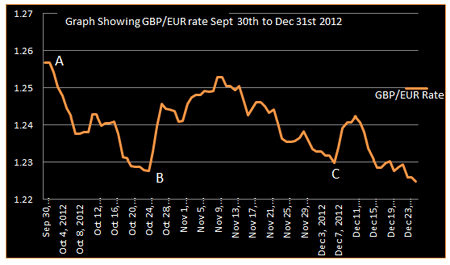Sterling Euro Currency Review Q4 2012
Tuesday 08 January 2013
Sterling performed negatively against the euro in Q4 as fears of a triple dip recession gripped the UK, writes Ben Scott.
Sterling touched a high of €1.2568 (interbank) in early October before reaching a low of €1.2186 (interbank) in the last week of December, trading at an average rate of €1.2383 during Q4 2012.
Once again the euro suffered from its relentless debt problems during this period as it continued to struggle with the on-going threat of debt contagion, and it is Sterling's failure again to establish gains against a distressed euro that continues to cause concern amongst euro buyers, as illustrated on the graph below.

The sharp decline in the GBP/EUR rate after Point A came amid enhanced euro performance on the back of market rumour and speculation, as opposed to any real signs of economic recovery.
Market expectation that European policy makers were getting to grips with the debt crisis, and the support provided by the European Central Bank (ECB) aimed at keeping borrowing costs at sustainable levels, resulted in the euro being one of the best performing currencies during Q4.
UK Economy Woes
Sterling was firmly on the back foot from Point A due to the plethora of negative economic data released - weak manufacturing and construction figures and a decline in the UK services sector, combined with a decrease in jobs in this sector, added to suggestions that further economic contraction was imminent.
This forecast contraction raised the devastating prospect of a triple-dip recession for the first time ever in the UK going into 2013, and sent Sterling spiralling as the International Monetary Fund (IMF) cut UK growth forecasts.
This raised questions about the UK's ability to sustain its revered AAA rating, which until this point had kept Government borrowing costs on a manageable footing and been credited for preventing the country following other European economies in requesting financial assistance. Any credit rating downgrade could prove disastrous for any hopes of a sustainable economic recovery in the UK.
Comments from Prime Minister David Cameron on 10th October, during the Conservative Party’s Annual Conference, confessing that the damage to the UK economy was worse than originally thought, and that the recovery will take longer than initially expected, added to Sterling’s woes.
This was not helped by lingering market concerns that further Quantitative Easing (QE) would be required from the Bank of England to stimulate economic growth, as QE impacts negatively on the local currency when implemented.
Euro Resists
Euro support came despite major euro-wide economic uncertainty in this period, including a significant decline in German economic output. Euro strength during this period can be attributed primarily to the actions of the ECB in providing a 'back-stop of last resort', as confidence grew that the recently introduced Outright Monetary Transactions (OMT), the ECB’s widely acclaimed bond-buying programme, would prove successful. However, as witnessed throughout Q4, the OMT’s policy had one main flaw, in that before it could be activated it had to be requested by the country in financial difficulty.
Despite its on-going debt crisis throughout this period Spain's refusal to request financial aid meant that the OMT simply remained a theoretical support mechanism, neither requested nor implemented. Spain did, however, add to the euro’s strength without requesting a bailout with 10-year bond yields falling from unsustainable levels above 7%.
This was not the case for some of its European neighbours who had previously been forced to seek financial assistance to satisfy their debt obligations to below 5.5%, making their debt far more manageable, and therefore reducing the potential of Spain seeking financial assistance, as hoped for by the ECB.
Further positivity for the euro in this period was provided by the growing belief that Greece would receive the next tranche of its bailout which was eventually rubber-stamped in early December. Although many economists failed to reach agreement over the significance it would have on the euro should Greece eventually default and leave the single currency, it appears undeniable that such an outcome seems appreciably more manageable than would have been the case at any time over the last three years, adding further strength to the euro.
Sterling Pulls Back
The period of Sterling strength, which appears immediately after Point B on the graph, came on the release of considerably better than expected Growth Domestic Production (GDP) figures for Q3 2012. The Office for National Statistics announced that the UK economy grew by 1% in Q3, surpassing expectations for a positive reading of between 0.7%-0.8% with growth of 1% representing the best growth figures in the UK for five years.
However any Sterling positivity was relatively short-lived, as it rapidly became apparent that underlying growth remained extremely weak and it was one-off factors such as the Olympics and Jubilee celebrations that accounted for between 0.7% and 0.8% of this growth. In other words, after several quarters of contraction the UK economy had only rebounded by a disappointing 0.2%-0.3% in Q3 2012.
After the initial positivity resulting from the GDP figures Sterling made further gains against the Euro on the back of deteriorating economic data throughout the eurozone before settling into a tight range against the euro.
It was in the period from Point B on the graph onwards that mixed economic data from the UK continued to prevent any further sustainable gains for Sterling against the euro. This was illustrated with the 30th October announcement from the Confederation of Business and Industry (CBI) that retail sale figures had been significantly higher than expected, allowing some appreciation for Sterling against the Euro. However, as is often the case, this gain was quickly negated on the announcement at the end of October that Consumer Confidence had fallen to a six-month low, adding further pressure to a struggling UK economy.
Sterling’s failure to gain significant ground through the €1.25 (interbank) levels on 7th November despite suggestions from ECB President Mario Draghi that the debt crisis was now having a detrimental impact on the German Economy, highlighting how little appetite there was to support Sterling against the euro at these levels.
UK economic negativity continued throughout November. A statement from rating agency Moody’s that “the UK would lose its AAA Credit Rating if it enters a triple dip recession”, resulted in Sterling losing ground against the euro despite the eurozone officially slipping into its second recession in two years in November, and France subsequently losing its AAA credit rating on 20th November, with Moody’s admitting France remained on outlook for further credit downgrades.
Eurozone growth downgrades from Point C meant Sterling was able to reverse losses experienced against the euro going into December despite markets giving an indifferent response to claims from UK Chancellor George Osborne in his ‘Autumn Statement’ that “Britain is still a good investment”.
Sterling weakness was again promptly re-established with Bank of England (BoE) member Fisher apparently keen to talk Sterling lower whilst providing a negative outlook for 2013, stating “a stronger pound is not helpful (to the UK economy) and that 2013 growth will be laborious”, before hinting at further QE in 2013, all of which had a considerably negative impact on Sterling.
Sterling weakness was compounded by final Q3 Gross Domestic Production (GDP) figures released at the end of December showing revisions lower from 1% to 0.9% suggesting any positivity surrounding the UK economy may well be misplaced, which could well be confirmed when Q4 GDP are released with expectations for the UK economy to contract in this period.
Outlook
Going forward numerous factors will determine the direction of GBP/EUR exchange rates in the short to medium term, yet there seems little potential for the rate to move higher than current levels and this will continue for as long as markets maintain their apparent attitude that anything bad has already happened in the eurozone, whilst maintaining it is unlikely that anything worse could conceivably happen in the short term.
The UK economy remains on the cusp of further contraction whilst the BoE’s desire for a weaker pound is likely to weigh heavily on Sterling through the first six months of 2013, particularly if further QE is eventually implemented by the Bank.
Mario Draghi and the European Central Bank appear to have provided a positive facility to counter the sovereign debt crisis experienced throughout the eurozone in the last few years; however, without actually being tested it seems unreasonable to speculate at to its significance as similar initiatives failed at the outset when attempts were made to implement a similar facility. Nevertheless, apparent recent harmony amongst European leaders is vital to euro stability which has certainly been lacking in recent years.
Further downgrades on growth forecasts continue to predict a gloomy UK outlook which will struggle to improve despite the arrival of newly elected BoE Governor Mark Carney in July.
The euro faces similar prospects following the recent resignation of Italy’s Prime Minister Mario Monti who was largely credited with steering Italy away from the edge of financial ruin. Monti’s decision could prove very negative for the euro, as illustrated by recent desperate attempts by European Leaders, including Chancellor Angela Merkel, to get him to reconsider.
Ben Scott
Foreign Exchange Ltd
www.fcexchange.co.uk
Thank you for showing an interest in our News section.
Our News section is no longer being published although our catalogue of articles remains in place.
If you found our News useful, please have a look at France Insider, our subscription based News service with in-depth analysis, or our authoritative Guides to France.
If you require advice and assistance with the purchase of French property and moving to France, then take a look at the France Insider Property Clinic.





